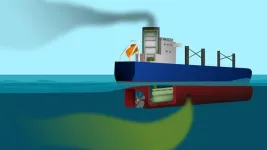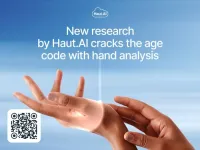(Press-News.org) A group of researchers from Chalmers University of Technology in Sweden, University of Freiburg and the Netherlands Institute for Neuroscience have created an exceptionally small implant, with electrodes the size of a single neuron that can also remain intact in the body over time – a unique combination that holds promise for future vision implants for the blind.
Often when a person is blind, some or part of the eye is damaged, but the visual cortex in the brain is still functioning and waiting for input. When considering brain stimulation for sight restoration, there needs to be thousands of electrodes going into an implant to build up enough information for an image. By sending electrical impulses via an implant to the visual cortex of the brain, an image can be created, and each electrode would represent one pixel.
“This image would not be the world as someone with full vision would be able to see it. The image created by electrical impulses would be like the matrix board on a highway, a dark space and some spots that would light up depending on the information you are given. The more electrodes that ‘feed’ into it, the better the image would be,” says Maria Asplund, who led the technology development part of the project and is Professor of Bioelectronics at Chalmers University of Technology in Sweden.
The vision implant created in this study can be described as a ‘thread’ with many electrodes placed in a row, one after the other. In the long term you would need several threads with thousands of electrodes connected to each one, and the results of this study are a key step towards such an implant.
The future of vision implants
An electrical implant to improve vision in people with blindness is not a new concept. However, the implant technology currently being explored in human patients is from the 1990s and there are several factors that need to be improved, for example the bulky size, scarring in the brain due to their large size, materials corroding over time and materials being too rigid.
By creating a really small electrode the size of a single neuron, researchers have the potential to fit lots of electrodes onto a single implant and build up a more detailed image for the user. The unique mix of flexible, non-corrosive materials make this a long-term solution for vision implants.
“Miniaturisation of vision implant components is essential. Especially the electrodes, as they need to be small enough to be able to resolve stimulation to large numbers of spots in the ‘brain visual areas’. The main research question for the team was, ‘can we fit that many electrodes on an implant with the materials we have and make it small enough and also effective?’ and the answer from this study was – yes,” says Professor Asplund.
The smaller the size, the worse the corrosion
To create an electrical implant on such a small scale comes with its challenges, especially in a tough environment, such as the human body. The major obstacle is not to make the electrodes small, but to make such small electrodes last a long time in a moist, humid environment. Corrosion of metals in surgical implants is a huge problem, and because the metal is the functional part, as well as the corroding part, the amount of metal is key. The electrical implant that Asplund and her team have created measures in at a miniscule 40 micrometers wide and 10 micrometers thick, like a split hair, with the metal parts being only a few hundred nanometers in thickness. And since there is so little metal in the super tiny vision electrode, it cannot ‘afford’ to corrode at all, otherwise it would stop working.
In the past, this problem has not been possible to solve. But now, the research team have created a unique mix of materials layered up together that do not corrode. This includes a conducting polymer to transduce the electrical stimulation required for the implant to work, to electrical responses in the neurons. The polymer forms a protective layer on the metal and makes the electrode much more resilient to corrosion, essentially a protective layer of plastic covering the metal.
“The conducting polymer metal combination we have implemented is revolutionary for vision implants as it would mean they hopefully could remain functional for the entire implant life-time. We now know it is possible to make electrodes as small as a neuron (nerve cell) and keep this electrode effectively working in the brain over very long timespans, which is promising since this has been missing until now. The next step will be to create an implant that can have connections for 1000s of electrodes,” says Asplund, something that is currently explored within a larger team in the ongoing EU project Neuraviper.
More about: the study method
The method was implemented by the research collaborators at the Netherlands Institute for Neuroscience, where mice were trained to respond to an electrical impulse to the visual cortex of the brain. The study showed that not only could the mice learn to react to the stimulation applied via the electrodes in just a few sessions, but the minimal current threshold for which mice reported a perception was lower than standard metal-based implants. The research team further reported that the functionality of the implant stayed stable over time, for one mouse even until the end of its natural lifespan.
More about the research:
The research has been published in the article: "Flexible Polymer Electrodes for Stable Prosthetic Visual Perception in Mice" published in Advanced Healthcare Materials. It is written by Corinne Orlemann, Christian Boehler, Roxana N. Kooijmans, Bingshuo Li, Maria Asplund and Pieter R. Roelfsema. The authors are active at the Netherlands Institute for Neuroscience, University of Freiburg and Chalmers University of Technology.
For more information, please contact:
Maria Asplund, Professor, Electronics Material and Systems, Microtechnology and Nanoscience, Chalmers University of Technology, Sweden maria.asplund@chalmers.se +46 31 772 41 14
Pieter R. Roelfsema, Department of Vision and Cognition, Netherlands Institute for Neuroscience, Royal Netherlands Academy of Arts and Sciences, Amsterdam, The Netherlands p.roelfsema@nin.knaw.nl
The Chalmers contact person speaks English and Swedish, and is available for live and pre-recorded interviews. At Chalmers, we have podcast studios and broadcast filming equipment on site and would be able to assist a request for a television, radio or podcast interview.
Collage CAPTION: The exceptionally small vision implant created in this study uses electrical impulses to stimulate the visual cortex of the brain, where information is converted into visual impressions, like pixels on a highway matrix board. Lower left corner: figure from the study - electrodes the size of a neuron are placed on implant “threads” as small as half a strand of hair. The implant is made of a non-corrosive material paving the way for a permanent – and more efficient - solution for the blind.
Collage CREDIT: top left eye: Unsplash, lower left: Chalmers University of Technology\ Maria Asplund, right illustration: iStock
NOTE TO THE EDITOR - IMAGES:
The Chalmers Press portal can be accessed here and you can search for any images or videos.
We kindly request credit to be given in the following format where possible:
Image/Graphic/Illustration: Chalmers University of Technology | Name Surname
Images provided in Chalmers University of Technology press releases are, unless specified otherwise, free for download and publication as long as credit is given to the University and the individual creator. Cropping and rescaling of the images is permitted when required for adaptation to the publication’s format, but modifications that would influence the message and content of the original are not. The material is primarily intended for journalistic and informative use, to assist in communication and coverage of Chalmers’ research and education. Commercial usage, for example the marketing of goods and services, is not permitted.
END
Breakthrough paves the way for next generation of vision implants
2024-05-07
ELSE PRESS RELEASES FROM THIS DATE:
New study finds increase in exposures to synthetic tetrahydrocannabinols among young children, teens, and adults
2024-05-07
(COLUMBUS, Ohio) – A sharp rise in exposures to synthetic cannabis products among youth — some leading to hospitalization — highlights the need for increased education around the dangers of exposure and increased focus on safe storage and packaging, according to pediatricians and researchers at Nationwide Children’s Hospital and the Central Ohio Poison Center.
A new study conducted by researchers at the Center for Injury Research and Policy of the Abigail Wexner Research Institute at Nationwide Children’s Hospital and the Central Ohio Poison Center examined trends in calls to poison ...
Dogma-challenging telomere findings may offer new insights for cancer treatments
2024-05-07
A new study led by University of Pittsburgh and UPMC Hillman Cancer Center researchers shows that an enzyme called PARP1 is involved in repair of telomeres, the lengths of DNA that protect the tips of chromosomes, and that impairing this process can lead to telomere shortening and genomic instability that can cause cancer.
PARP1’s job is genome surveillance: When it senses breaks or lesions in DNA, it adds a molecule called ADP-ribose to specific proteins, which act as a beacon to recruit other ...
Scientists cooked pancakes, Brussels sprouts, and stir fry to detect an oxidant indoors for the first time
2024-05-07
A feast cooked up by UBC researchers has revealed singlet oxygen indoors for the first time.
Oxi-don’t
Singlet oxygen is an oxidant. These chemical compounds can be beneficial—ozone in the stratosphere is one example—but can also cause stress to our lungs, contributing to the development of cancer, diabetes, and heart disease in the long term.
Cooking foods can release brown carbon, molecules with the potential to create oxidants when they absorb light. In addition, exposure to cooking emissions has been linked to chronic diseases in chefs.
Historically, it was thought there wasn’t enough light indoors to have much ...
Quantum breakthrough: World’s purest silicon brings scientists one step closer to scaling up quantum computers
2024-05-07
More than 100 years ago, scientists at The University of Manchester changed the world when they discovered the nucleus in atoms, marking the birth of nuclear physics.
Fast forward to today, and history repeats itself, this time in quantum computing.
Building on the same pioneering method forged by Ernest Rutherford – "the founder of nuclear physics" – scientists at the University, in collaboration with the University of Melbourne in Australia, have produced an enhanced, ultra-pure form of silicon that allows ...
New super-pure silicon chip opens path to powerful quantum computers
2024-05-07
Researchers at the Universities of Melbourne and Manchester have invented a breakthrough technique for manufacturing highly purified silicon that brings powerful quantum computers a big step closer.
The new technique to engineer ultra-pure silicon makes it the perfect material to make quantum computers at scale and with high accuracy, the researchers say.
Project co-supervisor Professor David Jamieson, from the University of Melbourne, said the innovation – published today in Communication Materials, a Nature journal – uses qubits of phosphorous atoms implanted ...
Millions in costs due to discharge of scrubber water into the Baltic Sea
2024-05-07
Discharge from ships with so-called scrubbers cause great damage to the Baltic Sea. A new study from Chalmers University of Technology, Sweden, shows that these emissions caused pollution corresponding to socio-economic costs of more than EUR 680 million between 2014 and 2022. At the same time, the researchers note that the shipping companies' investments in the much-discussed technology, where exhaust gases are "washed" and discharged into the sea, have already been recouped for most of the ships. This means that the industry is now making billions ...
Bio-inspired materials’ potential for efficient mass transfer boosted by a new twist on a century-old theory
2024-05-07
The natural vein structure found within leaves – which has inspired the structural design of porous materials that can maximise mass transfer – could unlock improvements in energy storage, catalysis, and sensing thanks to a new twist on a century-old biophysical law.
An international team of researchers, led by the NanoEngineering Group at the Cambridge Graphene Centre, has developed a new materials theory based on ‘Murray’s Law’, applicable to a wide range of next-generation functional ...
Small pump for kids awaiting heart transplant shows promise in Stanford Medicine-led trial
2024-05-07
A small, implantable cardiac pump that could help children await heart transplants at home, not in the hospital, has performed well in the first stage of human testing.
The pump, a new type of ventricular assist device, or VAD, is surgically attached to the heart to augment its blood-pumping action in individuals with heart failure, allowing time to find a donor heart. The new pump could close an important gap in heart transplant care for children.
In a feasibility trial of seven children who received the new pump to support their failing hearts, six ultimately underwent heart transplants ...
Time flies, but your hands tell: Haut.AI cracks the age code with hand analysis
2024-05-07
Tallinn, Estonia – 7th May 2024, 10 AM CET – Haut.AI, a leader in responsible skincare artificial intelligence (AI) development, today announced a breakthrough research paper demonstrating the effectiveness of using hand images for accurate age prediction. This innovative approach offers a viable alternative to traditional facial photo methods and promotes fairer AI solutions.
The study, titled “Predicting human chronological age via AI analysis of dorsal hand versus facial images: A study in a cohort of Indian females,” shows that AI models trained on hand images achieve comparable accuracy to those using facial images, with an average error of ...
Babraham Institute receives £48M strategic investment from BBSRC for a four-year programme of work to promote lifelong health
2024-05-07
Following a quinquennial review by the Biotechnology and Biological Sciences Research Council (BBSRC), the Babraham Institute will receive £48m for the period 2024-2028 to advance research on the mechanisms that maintain the health of our cells, tissues and organs across the life course.
This work is key in driving BBSRC’s strategic research priorities around an integrated understanding of health, developing and applying transformative technologies and advancing our understanding of the rules of life.
As one of eight UK bioscience ...






